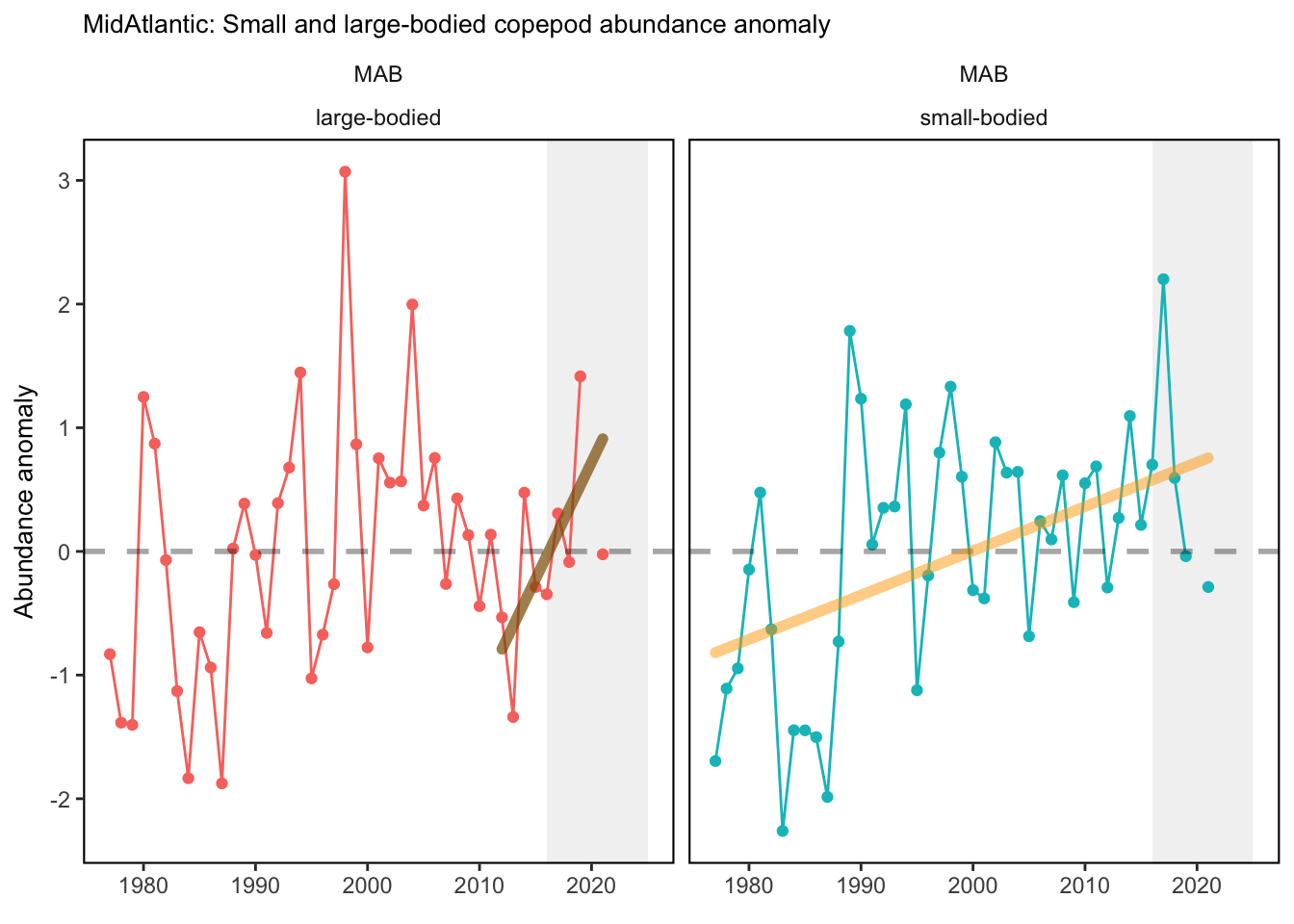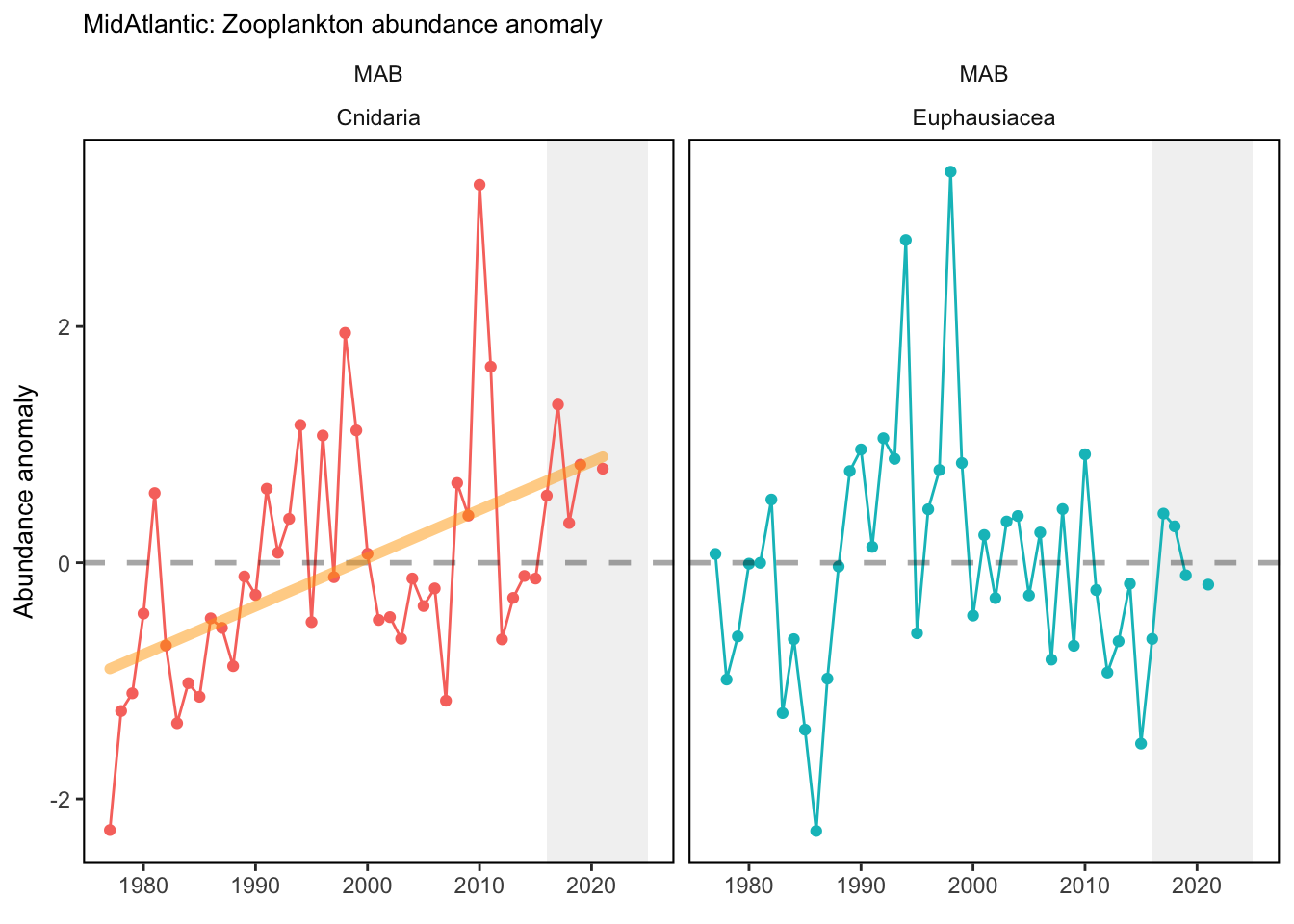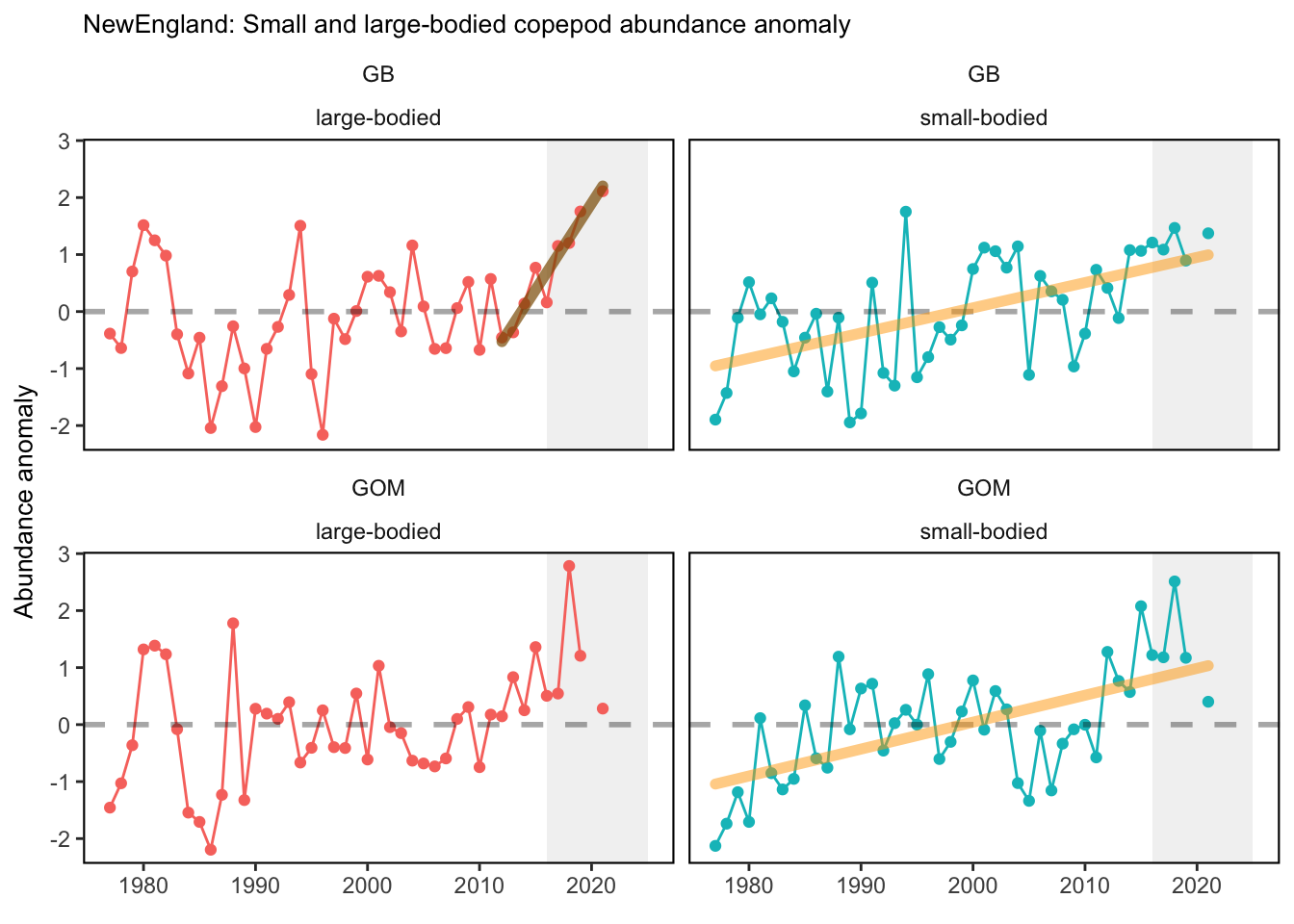SMART Indicator Report: Zooplankton Abundance Anomalies
2 Indicator name
Zooplankton Abundance Anomalies
Includes variable(s): Calfin, Chaetognatha, Cirripedia, Cnidaria, Cyclopoida, Decapoda, Diplostraca, Echinodermata, Euphausiacea, Gammaridea, Hyperiidea, LgCopepods, Mollusca, Mysidacea, Ostracoda, Polychaeta, Protozoa, Pteropod, SmCopepods, Tunicate
4 Indicator visualization
Abundance anomalies of small and large copepods have varied over time by EPU. Small bodied copepods and cnidarians show increasing trends in all EPUs. Large bodied copepods and euphausiids show no significant trend in any EPU.




5 Indicator documentation
5.1 Are indicators available for others to use (data downloadable)?
## Yes5.1.1 Where can indicators be found?
## Data: https://noaa-edab.github.io/ecodata/index.html
## Description: https://noaa-edab.github.io/catalog/zoo_abundance_anom.html
## Technical documentation: https://noaa-edab.github.io/tech-doc/zoo_abundance_anom.html5.1.2 How often are they updated? Are future updates likely?
[need sequential look at datasets for update frequency. Future requires judgement]
5.1.3 Who is the contact?
Ryan Morse, ryan.morse@noaa.gov; Harvey Walsh, harvey.walsh@noaa.gov; Kevin Friedland, kevin.friedland@noaa.gov
5.2 Gather indicator statistics
5.2.2 Length of time series, start and end date, periodicity
General overview: Annual
Indicator specifics:
Indicator | EPU | StartYear | EndYear | NumYears | MissingYears |
|---|---|---|---|---|---|
Calfin | GB | 1977 | 2021 | 45 | 0 |
Calfin | GOM | 1977 | 2021 | 45 | 0 |
Calfin | MAB | 1977 | 2021 | 45 | 0 |
Chaetognatha | GB | 1977 | 2021 | 45 | 0 |
Chaetognatha | GOM | 1977 | 2021 | 45 | 0 |
Chaetognatha | MAB | 1977 | 2021 | 45 | 0 |
Cirripedia | GB | 1977 | 2021 | 45 | 0 |
Cirripedia | GOM | 1977 | 2021 | 45 | 0 |
Cirripedia | MAB | 1977 | 2021 | 45 | 0 |
Cnidaria | GB | 1977 | 2021 | 45 | 0 |
Cnidaria | GOM | 1977 | 2021 | 45 | 0 |
Cnidaria | MAB | 1977 | 2021 | 45 | 0 |
Cyclopoida | GB | 1977 | 2021 | 45 | 0 |
Cyclopoida | GOM | 1977 | 2021 | 45 | 0 |
Cyclopoida | MAB | 1977 | 2021 | 45 | 0 |
Decapoda | GB | 1977 | 2021 | 45 | 0 |
Decapoda | GOM | 1977 | 2021 | 45 | 0 |
Decapoda | MAB | 1977 | 2021 | 45 | 0 |
Diplostraca | GB | 1977 | 2021 | 45 | 0 |
Diplostraca | GOM | 1977 | 2021 | 45 | 0 |
Diplostraca | MAB | 1977 | 2021 | 45 | 0 |
Echinodermata | GB | 1977 | 2021 | 45 | 0 |
Echinodermata | GOM | 1977 | 2021 | 45 | 0 |
Echinodermata | MAB | 1977 | 2021 | 45 | 0 |
Euphausiacea | GB | 1977 | 2021 | 45 | 0 |
Euphausiacea | GOM | 1977 | 2021 | 45 | 0 |
Euphausiacea | MAB | 1977 | 2021 | 45 | 0 |
Gammaridea | GB | 1977 | 2021 | 45 | 0 |
Gammaridea | GOM | 1977 | 2021 | 45 | 0 |
Gammaridea | MAB | 1977 | 2021 | 45 | 0 |
Hyperiidea | GB | 1977 | 2021 | 45 | 0 |
Hyperiidea | GOM | 1977 | 2021 | 45 | 0 |
Hyperiidea | MAB | 1977 | 2021 | 45 | 0 |
LgCopepods | GB | 1977 | 2021 | 45 | 0 |
LgCopepods | GOM | 1977 | 2021 | 45 | 0 |
LgCopepods | MAB | 1977 | 2021 | 45 | 0 |
Mollusca | GB | 1977 | 2021 | 45 | 0 |
Mollusca | GOM | 1977 | 2021 | 45 | 0 |
Mollusca | MAB | 1977 | 2021 | 45 | 0 |
Mysidacea | GB | 1977 | 2021 | 45 | 0 |
Mysidacea | GOM | 1977 | 2021 | 45 | 0 |
Mysidacea | MAB | 1977 | 2021 | 45 | 0 |
Ostracoda | GB | 1977 | 2021 | 45 | 0 |
Ostracoda | GOM | 1977 | 2021 | 45 | 0 |
Ostracoda | MAB | 1977 | 2021 | 45 | 0 |
Polychaeta | GB | 1977 | 2021 | 45 | 0 |
Polychaeta | GOM | 1977 | 2021 | 45 | 0 |
Polychaeta | MAB | 1977 | 2021 | 45 | 0 |
Protozoa | GB | 1977 | 2021 | 45 | 0 |
Protozoa | GOM | 1977 | 2021 | 45 | 0 |
Protozoa | MAB | 1977 | 2021 | 45 | 0 |
Pteropod | GB | 1977 | 2021 | 45 | 0 |
Pteropod | GOM | 1977 | 2021 | 45 | 0 |
Pteropod | MAB | 1977 | 2021 | 45 | 0 |
SmCopepods | GB | 1977 | 2021 | 45 | 0 |
SmCopepods | GOM | 1977 | 2021 | 45 | 0 |
SmCopepods | MAB | 1977 | 2021 | 45 | 0 |
Tunicate | GB | 1977 | 2021 | 45 | 0 |
Tunicate | GOM | 1977 | 2021 | 45 | 0 |
Tunicate | MAB | 1977 | 2021 | 45 | 0 |
5.2.3 Spatial location, scale and extent
General overview: by EPU
Indicator specifics:
Indicator | EPU |
|---|---|
Calfin | GB |
Calfin | GOM |
Calfin | MAB |
Chaetognatha | GB |
Chaetognatha | GOM |
Chaetognatha | MAB |
Cirripedia | GB |
Cirripedia | GOM |
Cirripedia | MAB |
Cnidaria | GB |
Cnidaria | GOM |
Cnidaria | MAB |
Cyclopoida | GB |
Cyclopoida | GOM |
Cyclopoida | MAB |
Decapoda | GB |
Decapoda | GOM |
Decapoda | MAB |
Diplostraca | GB |
Diplostraca | GOM |
Diplostraca | MAB |
Echinodermata | GB |
Echinodermata | GOM |
Echinodermata | MAB |
Euphausiacea | GB |
Euphausiacea | GOM |
Euphausiacea | MAB |
Gammaridea | GB |
Gammaridea | GOM |
Gammaridea | MAB |
Hyperiidea | GB |
Hyperiidea | GOM |
Hyperiidea | MAB |
LgCopepods | GB |
LgCopepods | GOM |
LgCopepods | MAB |
Mollusca | GB |
Mollusca | GOM |
Mollusca | MAB |
Mysidacea | GB |
Mysidacea | GOM |
Mysidacea | MAB |
Ostracoda | GB |
Ostracoda | GOM |
Ostracoda | MAB |
Polychaeta | GB |
Polychaeta | GOM |
Polychaeta | MAB |
Protozoa | GB |
Protozoa | GOM |
Protozoa | MAB |
Pteropod | GB |
Pteropod | GOM |
Pteropod | MAB |
SmCopepods | GB |
SmCopepods | GOM |
SmCopepods | MAB |
Tunicate | GB |
Tunicate | GOM |
Tunicate | MAB |
5.3 Are methods clearly documented to obtain source data and calculate indicators?
## Yes5.3.1 Can the indicator be calculated from current documentation?
[Build link to Tech-doc, look for current and previous methods]
5.4 Are indicator underlying source data linked or easy to find?
[Build link to Tech-doc, look for source, may require judgements]
5.4.1 Where are source data stored?
[Build link to Tech-doc, look for source, may require judgement]
6 Indicator analysis/testing or history of use
6.1 What decision or advice processes are the indicators currently used in?
Zooplankton represent a critical trophic link from primary producers to fish in marine ecosystems.
6.2 What implications of the indicators are currently listed?
Check these. If they are correct, we could be seeing the less energy dense zooplankton becoming more abundant in each system.
6.3 Do target, limit, or threshold values already exist for the indicator?
[Fill by hand; if not in key results or implications, likely does not exist]
6.4 Have the indicators been tested to ensure they respond proportionally to a change in the underlying process?
[Fill by hand; if not in introduction, key results, or implications, likely not tested]
7 Comments
[Fill below by hand once above data complete]
7.1 Additional potential links to management in addition to uses listed above
7.2 What additional work would be needed for the Council to use the indicator?
7.3 What issues are caused if there is a gap or delay in data underlying the indicator